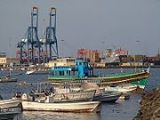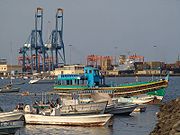
Port of Djibouti
Encyclopedia
The Port of Djibouti is located at the crossroads of one of the busiest shipping routes in the world, linking Europe
, the Far East
, the Horn of Africa
and the Persian Gulf
.
 Djibouti
Djibouti
as a main maritime passage and a main trading route between East and West stretches back 3,500 years, the time of maritime explorations of the Red Sea
. A strategic meeting point between Northeast Africa and the Arabian Peninsula
, the Red Sea was a place of contact and passage used by the Egyptians, the Phoenicia
ns, the Ptolemaists, the Romans
, the Greeks
, the Byzantine
s, the Arabs, and then by the Europeans in search of the Spice route. Its apogee came with the opening of the Suez Canal
.
The port evolved out of Ethiopia
's search for a maritime outlet to its railway line, and Djibouti’s coastline provided both easy access and sheltered anchorage. Work on the railway began in 1897, as did the initial construction of the port. Once the line was completed in 1917, the port grew rapidly. The Ethio-Djibouti Railways
is in process of rehabilitation to increase its capacity.
Development at the port increased further between 1948 and 1957 with the construction of four deep-water quays and the dredging of the port access channels. On land, new warehouses and oil storage facilities were built, electricity and water supplies provided and railway lines laid.
In 1952, the French oil company Pétroles de Somalie (now known as Total S.A.
) bunkered their first ship, and in 1956, Mobil Oil set up in Djibouti.
Between 1960 and 1970, port activity was developed as part of an international maritime exchange network. The Red Sea had become one of the busiest shipping lanes in the world, and Djibouti found itself acting as its service station. Bunkering traffic quadrupled in the ten years from 1954, reaching a peak of 1.8 million tons in 1965.
was the defining concept behind this new period of development and Djibouti’s first modern container terminal began operations in February 1985.
Since June 2000, the Port of Djibouti has been operated by Dubai Ports International on a 20-year concession.
Europe
Europe is, by convention, one of the world's seven continents. Comprising the westernmost peninsula of Eurasia, Europe is generally 'divided' from Asia to its east by the watershed divides of the Ural and Caucasus Mountains, the Ural River, the Caspian and Black Seas, and the waterways connecting...
, the Far East
Far East
The Far East is an English term mostly describing East Asia and Southeast Asia, with South Asia sometimes also included for economic and cultural reasons.The term came into use in European geopolitical discourse in the 19th century,...
, the Horn of Africa
Horn of Africa
The Horn of Africa is a peninsula in East Africa that juts hundreds of kilometers into the Arabian Sea and lies along the southern side of the Gulf of Aden. It is the easternmost projection of the African continent...
and the Persian Gulf
Persian Gulf
The Persian Gulf, in Southwest Asia, is an extension of the Indian Ocean located between Iran and the Arabian Peninsula.The Persian Gulf was the focus of the 1980–1988 Iran-Iraq War, in which each side attacked the other's oil tankers...
.
History

Djibouti
Djibouti , officially the Republic of Djibouti , is a country in the Horn of Africa. It is bordered by Eritrea in the north, Ethiopia in the west and south, and Somalia in the southeast. The remainder of the border is formed by the Red Sea and the Gulf of Aden at the east...
as a main maritime passage and a main trading route between East and West stretches back 3,500 years, the time of maritime explorations of the Red Sea
Red Sea
The Red Sea is a seawater inlet of the Indian Ocean, lying between Africa and Asia. The connection to the ocean is in the south through the Bab el Mandeb strait and the Gulf of Aden. In the north, there is the Sinai Peninsula, the Gulf of Aqaba, and the Gulf of Suez...
. A strategic meeting point between Northeast Africa and the Arabian Peninsula
Arabian Peninsula
The Arabian Peninsula is a land mass situated north-east of Africa. Also known as Arabia or the Arabian subcontinent, it is the world's largest peninsula and covers 3,237,500 km2...
, the Red Sea was a place of contact and passage used by the Egyptians, the Phoenicia
Phoenicia
Phoenicia , was an ancient civilization in Canaan which covered most of the western, coastal part of the Fertile Crescent. Several major Phoenician cities were built on the coastline of the Mediterranean. It was an enterprising maritime trading culture that spread across the Mediterranean from 1550...
ns, the Ptolemaists, the Romans
Ancient Rome
Ancient Rome was a thriving civilization that grew on the Italian Peninsula as early as the 8th century BC. Located along the Mediterranean Sea and centered on the city of Rome, it expanded to one of the largest empires in the ancient world....
, the Greeks
Ancient Greece
Ancient Greece is a civilization belonging to a period of Greek history that lasted from the Archaic period of the 8th to 6th centuries BC to the end of antiquity. Immediately following this period was the beginning of the Early Middle Ages and the Byzantine era. Included in Ancient Greece is the...
, the Byzantine
Byzantine
Byzantine usually refers to the Roman Empire during the Middle Ages.Byzantine may also refer to:* A citizen of the Byzantine Empire, or native Greek during the Middle Ages...
s, the Arabs, and then by the Europeans in search of the Spice route. Its apogee came with the opening of the Suez Canal
Suez Canal
The Suez Canal , also known by the nickname "The Highway to India", is an artificial sea-level waterway in Egypt, connecting the Mediterranean Sea and the Red Sea. Opened in November 1869 after 10 years of construction work, it allows water transportation between Europe and Asia without navigation...
.
The port evolved out of Ethiopia
Ethiopia
Ethiopia , officially known as the Federal Democratic Republic of Ethiopia, is a country located in the Horn of Africa. It is the second-most populous nation in Africa, with over 82 million inhabitants, and the tenth-largest by area, occupying 1,100,000 km2...
's search for a maritime outlet to its railway line, and Djibouti’s coastline provided both easy access and sheltered anchorage. Work on the railway began in 1897, as did the initial construction of the port. Once the line was completed in 1917, the port grew rapidly. The Ethio-Djibouti Railways
Ethio-Djibouti Railways
The Ethio-Djibouti Railways, also Ethio-Djibouti Railway Enterprise, is the successor of the Imperial Railway Company of Ethiopia and jointly owned by the governments of Ethiopia and Djibouti. It was formed after Djibouti gained independence in 1977 and received the French shares of the Imperial...
is in process of rehabilitation to increase its capacity.
Development at the port increased further between 1948 and 1957 with the construction of four deep-water quays and the dredging of the port access channels. On land, new warehouses and oil storage facilities were built, electricity and water supplies provided and railway lines laid.
In 1952, the French oil company Pétroles de Somalie (now known as Total S.A.
Total S.A.
Total S.A. is a French multinational oil company and one of the six "Supermajor" oil companies in the world.Its businesses cover the entire oil and gas chain, from crude oil and natural gas exploration and production to power generation, transportation, refining, petroleum product marketing, and...
) bunkered their first ship, and in 1956, Mobil Oil set up in Djibouti.
Between 1960 and 1970, port activity was developed as part of an international maritime exchange network. The Red Sea had become one of the busiest shipping lanes in the world, and Djibouti found itself acting as its service station. Bunkering traffic quadrupled in the ten years from 1954, reaching a peak of 1.8 million tons in 1965.
Regional hub
Djibouti’s strategic location enabled the port authorities to successfully rise to the challenge of turning the port into a regional hub for the Red Sea and Indian Ocean, and in a wider context the three continents of Europe, Africa and Asia. ContainerizationContainerization
Containerization is a system of freight transport based on a range of steel intermodal containers...
was the defining concept behind this new period of development and Djibouti’s first modern container terminal began operations in February 1985.
Since June 2000, the Port of Djibouti has been operated by Dubai Ports International on a 20-year concession.
Services
- Container Terminal
- General Cargo & CFS
- Free Zone

